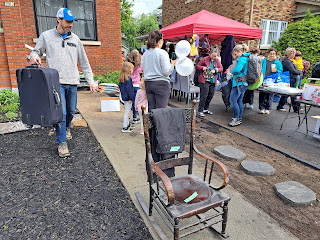https://bookswelove.net/stover-karla/
I
was at a big junk hunt last month and saw a small dress made from cloth
flour sacks. My Aunt Doris was
raised during the Depression and for Christmas she often gave me flour sack
kitchen towels which she’d embroidered. They’re very large and don’t dry well
but it’s a good sturdy cloth and I wouldn’t get rid of them for the world. And one
still has a flour odor imbedded in the fibers. I didn’t buy it; what I came
home with was two antique handbags to add to my collection and an old lantern.
The handbags I frame and hang on the bedroom wall and we have been Hanging old
lanterns on the patio roof beams. Over the years, I’ve bought old hatpins, old
books, a very peculiar hat, a necklace containing braided human hair, and this
year an alabaster elephant. Having said this, what I’d really like to have but
they’re way out of my budget is a Victorian seaweed album.
I only just learned about this
supposedly popular occupation for young ladies, described as “a romantic and safely-domesticated
way for them to explore the natural world” because they certainly weren’t
expected to study science for science’s sake. Of course, being women creating a
well-thought-out album was merely an artistic accomplishment.
Victorians were fascinated by
all-things-nature. What do General George Armstrong Custer, President Theodore
Roosevelt, and Queen Victoria have in common? A love of taxidermy. The general
tried his hand at it; the president had the animals he killed stuffed, and the
queen collected stuffed birds. My Aunt Doris shot and tanned a ring-necked
pheasant and gifted the skin to my husband.
The Victorians also created a
language of flowers and sent messages using only floral pictures, and developed
a love of terrariums. However, along about the same time they began collecting
seaweed.
In 1863, a children’s book author
names Margaret Gatty wrote British Sea-weeds, a handbook for amateurs. The
book introduced readers to some of the species’ varieties, and offered suggestions
for the proper attire when collecting (no petticoats below the ankle) and she
strongly suggested taking along a male companion. Her illustrations showing
some of the different varieties were to help with the correct identification of
samples obtained.
Eighteen years later, a man named
Alpheus Baker Hervey wrote the book, Sea Mosses: a collector’s guide, and an
introduction to the study of marine algae. The tools he suggested were a
pair of pliers to handle the specimens, scissors to cut away what he called “superfluous
branches,” a stick with a needle on the end to be used to move the seaweed
around so as to reveal its finer points, at least two wash bowls to clean it, paper
such as a botanist’s drying paper or blotting paper using multiple sheets to
dry it between, cotton cloth, and cards on which to mount the specimens.
I googled looking for the numbers
of seaweed a.k.a algae, available for an album and it ranges between seven and
twelve thousand types, generally comes in red, green or brown, and ranges in
appearance from delicate, lacy fronds to leafy blades to the enormous growths
in a kelp forest.
May,
2, 2025 The News Tribune
In late April, Washington Department of Fish and Wildlife
Police announced that they had issued a citation to a group for harvesting
seaweed near Sekiu on the Olympic Peninsula.
I grew up
on Commencement Bay and things have really changed. The beaches are no longer
covered in shells. My mom, Aunt Elizabeth and I used to collect tiny shells
which may or may not have been screw shells. We dug geoducks; mussels clung to
every piling. We had as many oysters as we wanted and Mom once found a pearl. Now,
when I want their shell remains, the beaches are bare. And we have two new food
sources, squid and seaweed. In summer we’ve seen members of our Asian
population raking in seaweed from the bay and draping it over driftwood to dry.
In mid-winter, they jig for squid off
the peers. With so many people wanting to supplement their food supplies, the
state had to create strict laws and require licenses. Bur, I digress.
I almost
never meet a hobby I don’t like. My latest are making pine needle baskets and
creating little pictures with sea glass, also very hard to find. I’m not sure
if I want to try a seaweed album, though. But if I do, one thing is for sure;
it will certainly wig-out my poor husband.








.jpg)




%20-%20Copy.jpg)




























